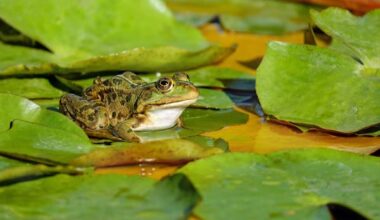Ever wondered how to keep those crafty raccoons from raiding your bird feeders at night? Well, you’re in luck! I’ve spent countless nights studying the habits of these masked marauders and have come up with some ingenious coon feeder ideas that are sure to outsmart even the trickiest of raccoons.
Firstly, let’s address the problem we all face. One minute our bird feeders are brimming with seeds for our feathered friends, then – BAM! – a sneaky raccoon is having an all-you-can-eat buffet while we sleep. It’s frustrating, isn’t it? But don’t wave your white flag just yet!
From creating strategic placements and investing in coon-proof materials to using baffles or opting for weight-activated feeders; there exists a plethora of ways you can protect your precious seeds from these nocturnal bandits. In this article, we’ll dig into each idea in detail so that by the end; Mr Raccoon will have met his match!
Here is an article you might be interested in crawlspace furnace
Here is also another exciting article to read crawlspace heaters

Types of Coon Feeders: Gravity versus Spin Cast
When it comes to coon feeders, there are two main types:
1. Gravity feeders
2. Spin cast feeders
Gravity feeders rely on the force of gravity to dispense food slowly over time. These are great for providing a constant supply of food without too much effort on your part.
On the other hand, spin cast feeders use spinning mechanisms to scatter food across a wider area. This type of feeder is ideal if you want to attract more raccoons or if you have a larger area that needs coverage.
Best Location to Install a Coon Feeder
Now that you know about different types of coon feeders, it’s important to consider where best to install them. You want to choose an area that is easily accessible for both you and the raccoons while also ensuring their safety.
A good location would be near natural water sources such as ponds or rivers where raccoons are likely already present. Additionally, placing them near trees or shrubs can provide shelter and make them feel more secure while feeding.
Materials and Construction of High-Quality Coon Feeders
When investing in a coon feeder, quality is key. Look for feeders made from durable materials such as steel or heavy-duty plastic that can withstand various weather conditions and the occasional raccoon antics.
Additionally, consider the construction of the feeder. Opt for designs that are sturdy and have reinforced parts to ensure long-term usage.
By selecting high-quality materials and well-constructed feeders, you’ll be providing a reliable feeding station for your raccoon visitors.
Key Features to Look for in a Raccoon Feeder
Choosing the right features in a raccoon feeder can make all the difference in attracting these creatures to your property. Here are some key elements to consider:
1. Adjustable Settings:
Look for feeders with adjustable dispensing settings so you can control how much food gets released at each feeding time.
2. Pest-Proof Design:
Raccoons aren’t the only critters attracted to food, so look for feeders with pest-proof features like lockable lids or squirrel baffles.
3. Easy Cleaning Access:
Make sure your chosen feeder has easy-to-access components that allow thorough cleaning to maintain hygiene standards.
Remember, when it comes to raccoon feeders, convenience and functionality go hand-in-hand!
Tips on Filling and Maintenance for Longevity of The Feeder
To keep your coon feeder functioning optimally and lasting longer, proper filling and regular maintenance are essential! Follow these tips:
1. Regularly clean out any leftover food or debris from within the feeder using mild soap water.
2. Adjust fill levels based on raccoons’ needs; avoid overfilling as it may lead to wastage or attract unwanted pests.
3. Modify feeding patterns according to seasons – provide more food during colder months when natural resources are scarce.
By following these tips, you’ll ensure that your coon feeder remains in top-notch condition for the enjoyment of both raccoons and yourself!
Common Mistakes to Avoid When Setting Up a Coon Feeder
Setting up a raccoon feeder may seem like an easy task, but there are common mistakes you should avoid. Here’s what to watch out for:
1. Poor Security Measures: Ensure that your feeder is securely mounted or anchored to prevent raccoons from knocking it over or causing damage.
2. Inadequate Food Protection: Make sure the feeder has protection against weather elements, preventing spoilage and maintaining freshness of the food.
3. Ignoring Local Regulations: Before installing a coon feeder, familiarize yourself with local laws and regulations regarding wildlife feeding on private property.
Avoiding these common mishaps will save you time, money, and frustration in the long run while keeping your furry visitors happy and safe!
Safety Precautions When Handling and Installing a Raccoon Feeder
While setting up a raccoon feeder can be an exciting project, it’s crucial to prioritize safety at all times. Here are some essential precautions:
1. Use gloves when handling feeders to protect yourself from any sharp edges or potential contamination.
2. Make sure there are no hazards nearby such as sharp objects or uneven surfaces that could cause injury during installation.
3. While it can be tempting to get close to observe raccoons feeding, always maintain a safe distance as they may feel threatened.

Attracting Wildlife: Ideal Foods for Your Coon Feeders
To maximize attraction towards your coon feeder, it’s crucial to offer foods that raccoons love. Here are some ideal food options:
1. Fruits and Vegetables
Raccoons have a wide-ranging diet, so offering fruits like apples or vegetables like corn can be enticing.
2. Nuts and Seeds
Providing nuts such as peanuts or seeds such as sunflower seeds can attract raccoons seeking a protein-rich snack.
3. Commercial Wildlife Food
Consider using specially formulated commercial wildlife food that is designed to meet the nutritional needs of raccoons.
By offering these tasty treats, you’ll be creating an irresistible buffet for your furry visitors!
DIY Projects: Building Your Own Effective Raccoon Feeder
If you’re feeling adventurous and want to take on a DIY project, building your own raccoon feeder could be a fulfilling endeavor. There are numerous online resources with step-by-step guides and creative ideas for constructing functional feeders from readily available materials.
Not only will this allow you to personalize the design according to your preferences but also provide you with a sense of accomplishment in attracting wildlife through your creativity!
Pros and Cons of Commercially Available Coon Feeders
While DIY projects are exciting, commercially available coon feeders come with their own set of advantages and disadvantages. Let’s explore them:
PROS:
– Convenient Solution: Buying pre-made feeders saves time and effort compared to building one from scratch.
– Advanced Features: Commercial feeders often come equipped with innovative features that enhance functionality.
CONS:
– Limited Customization: Unlike DIY projects, commercially available feeders may not offer as much customization potential.
– Higher Cost: The convenience provided by commercial options usually comes at a higher price point than DIY alternatives.
Consider these pros and cons when making the decision between purchasing or building a coon feeder based on your individual preferences!
Raccoons’ Behavior Towards Different Types of Food and Feeders
It’s important to understand raccoons’ behavior when it comes to different types of food and feeders. Factors such as the type of food offered, feeder design, and placement can influence their feeding habits.
For example, raccoons are known for their dexterity when using gravity feeders, while spin-cast feeders may attract more raccoons due to the wider scatter pattern. Similarly, certain foods like meat or fish can pique their interest more than fruits or nuts.
Observe and experiment with various options to find out what works best for attracting raccoons in your area!
A Final Word
By incorporating these ten innovative coon feeder ideas into your wildlife feeding strategies, you’ll create an enticing haven for raccoons on your property. So go ahead and choose from gravity versus spin cast feeders, select high-quality materials, implement key features, avoid common mistakes while setting up a feeder safely, and consider ideal foods that appeal to raccoons’ palates.
Whether you opt for commercial options or embark on a DIY project – remember that each decision contributes to enhancing your wildlife experience through effective coon feeder techniques!
Read another exciting blog post here crawlspace mold spray
This is the article to read for today crawlspace storage ideas
FAQs
Q: What is the purpose of this comprehensive guide about Coon Feeders?
A: This guide is here to provide you with ideas to improve your wildlife feeding strategies using Coon Feeders.
Q: How can Coon Feeders enhance my wildlife feeding strategies?
A: Coon Feeders can help attract and feed various wildlife, such as deer, hogs, and even coyotes, by providing a consistent food source.
Q: What are some common terms used in relation to Coon Feeders?
A: Some common terms related to Coon Feeders include forum, bucket, deer, dog food, trap, hole, ground, tire, gallon, pipe, gallon bucket, bottom, pup, 5 gallon bucket, smell, eat, cheap, hog, lure, pvc, grape, dry, yard, drill, sweet, rim, add, bear, pull, bait, sour, bag, hang, pour, foot, trail, peanut butter, keep the hogs, oil, mix, 5 gal, 3 inches, time of year, cheap dog food, still on the rim, vanilla, one time, bottle, hook, dry cat food, drag, setup, piece of pvc, kool aid, sidewall, kool-aid, dozen, ice, yotes, get em, syrup, shake, pesky, plenty, also get, worry, better experience, appreciate, moonshine, cheapest, and 18.
Q: How can I attract animals to the Coon Feeder?
A: You can use enticing baits, such as cheap dog food or dry cat food, to lure the animals to the Coon Feeder. Peanut butter, vanilla, or even some syrup can also be effective in attracting them.
Q: Is it necessary to hang the Coon Feeder?
A: No, it is not necessary to hang the Coon Feeder. Placing it on the ground can also work well, especially for animals like deer and hogs.
Q: Can I use a 5-gallon bucket as a Coon Feeder?
A: Absolutely! A 5-gallon bucket can be a great option for a Coon Feeder. Simply drill a few holes in the bottom to allow the animals to access the food.
Q: How do I keep the Coon Feeder from being torn apart by hogs?
A: To prevent hogs from destroying the Coon Feeder, you can reinforce it by attaching a piece of PVC pipe to the bottom. This will make it more durable and hog-proof.
Q: How often should I refill the Coon Feeder?
A: The frequency of refilling the Coon Feeder will depend on the amount of wildlife activity in your area. However, it is generally recommended to check and refill it every few days or as needed.
Q: Can I use Coon Feeders to attract other animals besides raccoons?
A: Definitely! Coon Feeders can also attract animals like deer, hogs, and even coyotes. So, you might end up having visitors from various wildlife species.
Q: What are some common mistakes to avoid when using Coon Feeders?
A: One common mistake is leaving the Coon Feeder empty for an extended period, as this can discourage animals from returning. It’s also important to ensure the bait stays fresh and doesn’t spoil.

